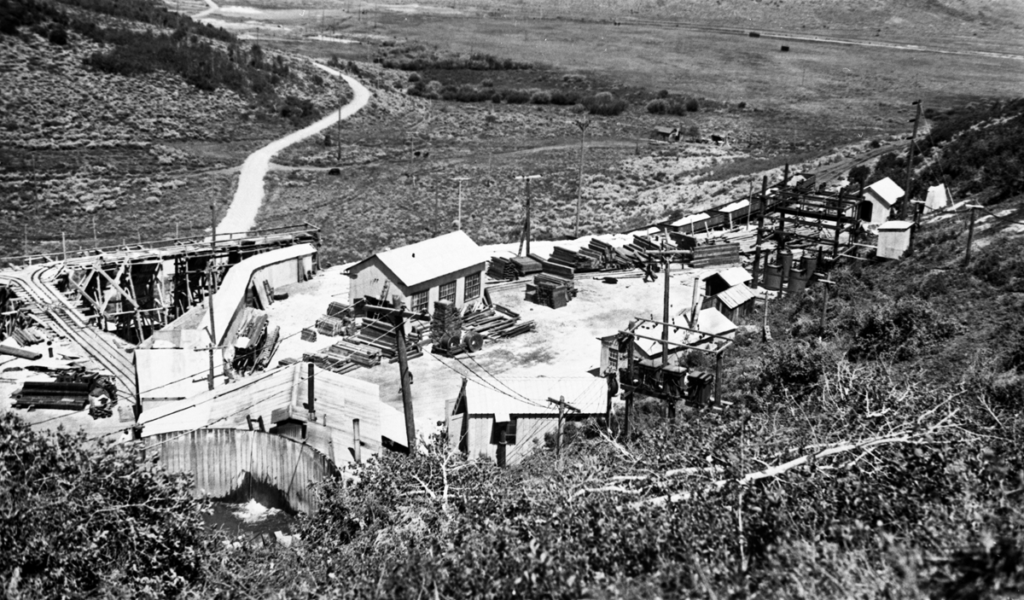The Wasatch Mountains have delivered “treasure” to the community of Park City since the town’s birth in the early 1870’s. Known as a silver mining town, Park City owes its existence to valuable ores.
The most notable Park City mines included the Ontario, Silver King, Judge and Daly West. Collectively referred to as The Big Four, they produced significant amounts of silver, lead, and zinc, but only trace amounts of gold. Being overshadowed by The Big Four, three smaller Park City mines were gold producers.
The first, the American Flag Mine, was incorporated in 1902. The mine’s value was based upon its potential gold reserves – a rarity in Park City. The main shaft would eventually reach a depth of 1,300 feet with fourteen active levels (drifts). The mine was close enough to town that no boarding house was required – the men could walk to work.
Labor unrest, resulting from a reduction in wages and hours (courtesy of the Great Depression) closed the mine. A 1934 fire destroyed the surface buildings. They were rebuilt based upon a conviction that a “mother lode” of gold remained undiscovered. By the early 1940s the American Flag was leased to Andy Hurley. He employed a few men in pursuit of that mother lode, which was not to be found.
A second gold mine was the Park City Consolidated Mine (the Park Con). It commenced full production in August of 1929. Silver, gold, and lead reserves proved abundant – along with copious amounts of water. The Park Con was located on the eastern side of what is now lower Deer Valley, the surface works sprawled over the area that now supports the St. Regis Hotel and Snow Park. A rail spur traversing Deer Valley Drive jointly operated by the Union Pacific and Denver & Rio Grande Railroads served the mine.
Unfortunately for the Park Con, it achieved the dubious honor as Utah’s “hard luck” mine. From 1929 to 1939 the mine was one of the most prolific producers in the state. However, the Great Depression ensured that historically low prices would be paid for its ores. A further challenge for the mine was the expense of mitigating substantial water flows. These twin problems dogged the mine in its brief period of existence. Another headache manifested itself in 1939: labor unrest. Workers went on strike demanding higher wages. After ten years of marginally profitable operations the investors had enough. The Park Con closed, never to reopen.

Credit: Park City Historical Society & Museum, Park Con Mining Company Collection
The Mayflower Mine holds the title as Park City’s undisputed champion of gold production. It was located on the back side of Deer Valley in Wasatch County (as opposed to the original Mayflower Mine in Woodside Gulch, which produced silver, lead, and zinc). A new ski property, the Mayflower Mountain Resort, is now being developed on the former mine location.
The newcomer Mayflower opened in 1929. This was the last Park City mine to open and the second last to close (in 1972). A joint venture between Hecla Mining and the New Park Mining Company finalized in 1961 unleashed the potential of this mine: By 1966 it was the sixth largest producer of gold in the U.S.
In 1972 the price for gold had declined to $64 per troy ounce ($418 in today’s money). At that price point profitable mining operations proved unsustainable. Hecla reluctantly closed the Mayflower despite estimates that another 175 tons of ore could be mined, yielding 75,000 troy ounces of gold (a number that would yield over $135 million based on 2021 gold prices and money).
By 1979, with the price of gold at $800 per troy ounce ($3,000 in today’ money), consideration was given to reopen the mine. Legal and operational obstacles proved insurmountable. Likewise, in 1984, with the price of gold exceeding $300 a troy ounce ($788 in today’s money), a brilliant young mining engineer proposed reopening the American Flag by accessing it from the Ontario Mine. All operational, engineering, and financial considerations were addressed. Nonetheless, securing the required capital was not to be.
Since then, the local economy embraced a previously scorned local natural resource: water. The nuisance which plagued the mining industry now supports snow making for billion-dollar resorts and provides drinks and showers for the burgeoning population of Park City. Thus, the mountains of Park City continue to sustain our economic health as they have for 150 years. A glass of liquid gold, anyone?
The Park City Museum is hosting a new traveling exhibit from September 12 through November 7 titled Gold Fever! Untold Stories of the California Gold Rush.
I am indebted to Keith Droste and Jim Hewitson for this article. Keith was the superintendent of the Mayflower mine from 1966 to 1969. Jim is a fourth generation Park City miner who worked with UPCM (and other mostly western mining operations).